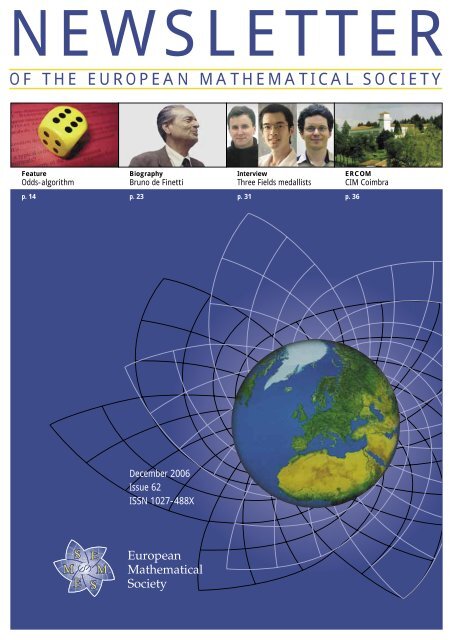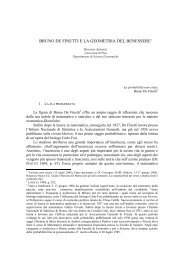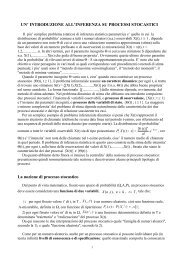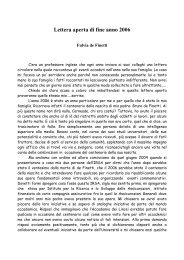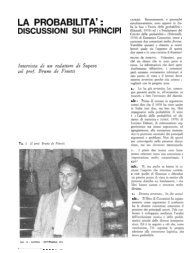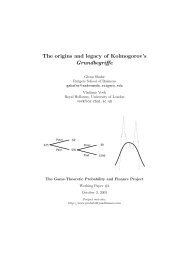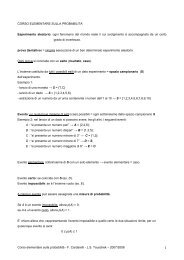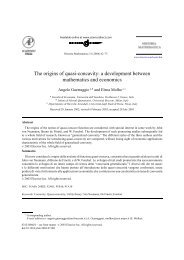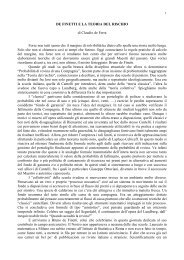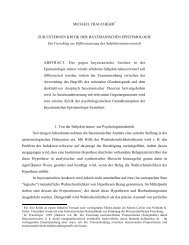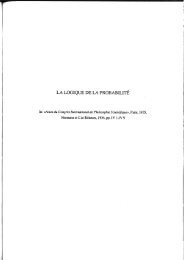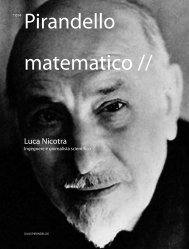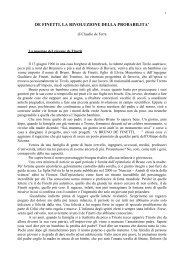OF THE EUROPEAN MATHEMATICAL SOCIETY - Bruno de Finetti
OF THE EUROPEAN MATHEMATICAL SOCIETY - Bruno de Finetti
OF THE EUROPEAN MATHEMATICAL SOCIETY - Bruno de Finetti
You also want an ePaper? Increase the reach of your titles
YUMPU automatically turns print PDFs into web optimized ePapers that Google loves.
NEWSLETTER<strong>OF</strong> <strong>THE</strong> <strong>EUROPEAN</strong> MA<strong>THE</strong>MATICAL <strong>SOCIETY</strong>FeatureOdds-algorithmp. 14Biography<strong>Bruno</strong> <strong>de</strong> <strong>Finetti</strong>p. 23InterviewThree Fields medallistsp. 31ERCOMCIM Coimbrap. 36December 2006Issue 62ISSN 1027-488XSMEEMSEuropeanMathematicalSociety
Biography<strong>Bruno</strong> <strong>de</strong> <strong>Finetti</strong> (1979)on probability can be found in the two volumes [4] of hisbest known book Teoria <strong>de</strong>lla Probabilità (1970), which wastranslated into English in 1975. However, his contributionsto probability and statistics do not reduce to his subjectiveapproach; they inclu<strong>de</strong> important results on finitely additivemeasures, processes with in<strong>de</strong>pen<strong>de</strong>nt increments, sequencesof exchangeable variables and associative means (see the review[5] for <strong>de</strong>tails on these).(a) The concepts of probability in <strong>de</strong> <strong>Finetti</strong>’s time: until the1920’s it was tacitly assumed that the frequentist interpretativei<strong>de</strong>as of probability played the main role in the various applicationsof the discipline, or at least the most popular methodsof assessment were based on a combinatorial approach oron an observed frequency. The i<strong>de</strong>a of subjective probabilitywas almost surely un<strong>de</strong>rmined by the <strong>de</strong>velopments in physicsafter a few consi<strong>de</strong>rations on it given by a couple of Frenchscientists (E. Borel (1924) and P. Lévy (1925); see [10] for asuitable reference).Since his early days as a mathematician, <strong>Bruno</strong> <strong>de</strong> <strong>Finetti</strong>revitalized the theory of subjective probability in a very differentspirit with respect to the past. De <strong>Finetti</strong> probabilism(as he called it in [2]) is the “true heir of the empiricist philosophicaltradition in the spirit of David Hume ... <strong>de</strong> <strong>Finetti</strong>was a prodigy who could make his philosophical and conceptuali<strong>de</strong>as match his mathematical <strong>de</strong>velopments” [10]. Inan interesting correspon<strong>de</strong>nce with M. Fréchet in the 1930’s<strong>de</strong> <strong>Finetti</strong>, discussing some papers concerning the almost sureconvergence of a sequence of in<strong>de</strong>pen<strong>de</strong>nt and i<strong>de</strong>ntically distributedbernoullian random variables, states that the problemsconcerning stochastic convergence are mere signs of a<strong>de</strong>eper problem concerning the correct mathematical <strong>de</strong>finitionof probability. As a matter of fact, in his opinion, the<strong>de</strong>finition has to adhere to the intuitive notion of probabilityas it is conceived by every one of us in usual everyday life.He maintains that one has no right to make arbitrary use ofthe properties introduced to give a mathematical <strong>de</strong>finition ofprobability. In<strong>de</strong>ed, these very properties have to be not onlyformally consistent but also intrinsically necessary with respectto a meaningful interpretation of probability. De <strong>Finetti</strong>shares Fréchet’s opinion implying that each concept, even ofa mere mathematical nature, is more or less directly triggeredby intuition. Nevertheless, this <strong>de</strong>finition can effectively bearbitrary, provi<strong>de</strong>d that one confines oneself to <strong>de</strong>duce purelyformal conclusions from it. This turns out to be the case in the<strong>de</strong>finition of measure. A different case is connected with the<strong>de</strong>finition of weight, since we cannot force a pair of scales towork according to our <strong>de</strong>finition.De <strong>Finetti</strong> proposed a thought experiment along the followinglines (a philosophical gambling strategy): you mustset the price of a promise to pay 1 (lira in <strong>de</strong> <strong>Finetti</strong>’s time)if, for instance, there was life on Mars one billion years agoand 0 if there was not, and tomorrow the answer will be revealed.You know that your opponent will be able to chooseeither to buy such a promise from you at the price you haveset, or require you to buy such a promise from them, still atthe same price. In other words, you set the odds but your opponent<strong>de</strong>ci<strong>de</strong>s which si<strong>de</strong> of the bet will be yours. The priceyou set is the operational subjective probability that you assignto the proposition on which you are betting. This pricehas to obey the probability axioms if you are not to face certainloss, as you would if you set a price above 1 (or a negativeprice). It is seen that in any application of probability theorywe can interpret the probabilities as personal <strong>de</strong>grees of beliefof a rational agent; this is the term reserved for a personwho will not accept a Dutch book. By consi<strong>de</strong>ring bets onmore than one event <strong>de</strong> <strong>Finetti</strong> could justify additivity. Prices,or equivalently odds, that do not expose you to certain lossthrough a Dutch book are called coherent. Probability will bethe <strong>de</strong>gree of belief assigned by you to the occurrence of anevent.The mathematical formulation of probability IP was givenin [2]. Given a class E of events and an element A of the class,any p ∈ [0,1] represents a coherent assessment on A. After<strong>de</strong>fining a probability <strong>de</strong> <strong>Finetti</strong> proves that the usual rulesof the calculus of probability are necessary for the coherenceof IP on E, i.e., he states the well known properties (exceptσ-additivity):If IP is a probability on a class E,wehave:1. A ∈ E =⇒ IP(A) ∈ [0,1];2. Ω ∈ E =⇒ IP(Ω)=1(hereΩ is the certain event);3. if A 1 ,···,A n ∈ E, ∪ n k=1 A k ∈ E and A i ∩ A j = /0 fori ≠ j then IP(∪ n k=1 A k)=∑ n k=1 IP(A k).These classical properties, i.e., the fact that IP is a functionwhose range lies between 0 and 1 (these two extremevalues being assumed by, but not kept only for, the impossibleand the certain events respectively) and which is additivefor mutually exclusive events, constitute the starting point inthe axiomatic approach; so <strong>de</strong> <strong>Finetti</strong> can rightly claim thatthe subjective view can only enlarge and never restrict thepractical purport of probability theory.26 EMS Newsletter December 2006
BiographySubsequently, in 1949, with regard to the problem of existenceof at least a probability on a given class of events, heprovi<strong>de</strong>d the following extension theorem:If A and B are classes of events such that A ⊂ BandIP 1is a probability on A, then there is a probability IP 2 on B suchthat IP 1 = IP 2 on A.He also showed that the previous methods (i.e., the combinatorialand the frequentist methods) can be recovered if someuseful (even if very particular) methods of coherent evaluationare consi<strong>de</strong>red; they are subjective as well and they are unnecessarilyrestricted to the domain of applicability. De <strong>Finetti</strong>also makes absolutely clear the distinction between the subjectivecharacter of the notion of probability and the objectivecharacter of the elements (i.e., events) to which it refers.Although there is no reason why different interpretations(senses) of a word cannot be used in different contexts, thereis a history of antagonism between the followers of <strong>de</strong> <strong>Finetti</strong>(sometimes called Bayesians) and frequentists, with the latteroften rejecting the subjective interpretation as ill-groun<strong>de</strong>d.The groups have also disagreed about which of the two sensesreflects what is commonly meant by the term probable. In thepreface of many books concerning probability theory there isa wi<strong>de</strong> trace of this controversial dispute. Today the long waveof the subjective approach of <strong>de</strong> <strong>Finetti</strong> is growing more andmore in the field of assessments of probability. All the work of<strong>de</strong> <strong>Finetti</strong> exhibits an intuitionist and constructivist view, witha natural bent for submitting the mathematical formulation ofprobability theory only to the needs required by any practicalapplication.(b) Stochastic processes with in<strong>de</strong>pen<strong>de</strong>nt increments:thecrisisof <strong>de</strong>terminism and of the casuality principle introduces anovelty into the scientific method. Rigid laws stating that acertain fact is bound to occur in a certain way are being replacedby probabilistic or statistical laws stating that a certainfact can occur <strong>de</strong>pending on a variety of ways governed byprobability laws. Thus, given a scalar quantity whose temporalevolution is <strong>de</strong>scribed by X = X(t), t ≥ 0, one assumes thatthe values taken by X(t) are known for t ≤ t 0 and consi<strong>de</strong>rs theconditional increment {(X(t) − X(t 0 )/X(u),u ≤ t 0 , t > t 0 }.As far as the probability distribution function F(·) of such anincrement is concerned, <strong>de</strong> <strong>Finetti</strong> consi<strong>de</strong>rs the three cases:1. F(·) is in<strong>de</strong>pen<strong>de</strong>nt of X(u) for every u ∈ [0,t 0 ] -(F(·) iscalled known);2. F(·) is in<strong>de</strong>pen<strong>de</strong>nt of X(u) for every u ∈ [0,t 0 ) -(F(·) iscalled differential);3. F(·) is <strong>de</strong>pen<strong>de</strong>nt on X(u) on [0,t 0 ] -(F(·) is called integral).De <strong>Finetti</strong> <strong>de</strong>als with the problem of characterizing the probabilitydistribution of X(t): ifX(0)=0andφ t , ψ t <strong>de</strong>note theprobability distribution function and the characteristic functionof X(t) respectively, then {ψ 1n(·)} n is the characteristicfunction of the sum of n in<strong>de</strong>pen<strong>de</strong>nt increments, i<strong>de</strong>nticallydistributed according to the law X(t) − X(0). In mo<strong>de</strong>rn literaturethese processes are known as processes with homogeneousin<strong>de</strong>pen<strong>de</strong>nt increments and ψ 1 [= (ψ 1n) n ] is calledthe infinitely <strong>de</strong>composable characteristic function; <strong>de</strong> <strong>Finetti</strong>shows that ψ t is continuous whenever X is continuous on[0,+∞) and X(t) is different from ct. Moreover the exampleschosen to emphasize the relevance of the continuity forX are very noteworthy: the Poisson process and the compoundPoisson process. The method <strong>de</strong> <strong>Finetti</strong> uses here is quite innovativewith respect to the past. Finally he achieves the wellknown result:The class of infinitely <strong>de</strong>composable laws coinci<strong>de</strong>s withthe class of distributions limits of finite convolutions of distributionsof Poisson type.This result was a starting point for a subsequent series ofpapers by A. N. Kolmogorov and P. Lévy.(c) Exchangeability: the works of P. Levy and G. Castelnuovo(from 1925 to 1928) taught him the analytical tools for arrivingat one of the most important results in the theory of probability,i.e., the concept of exchangeability of events (1928),followed (in 1929) by the probability laws of continuous timerandom processes.With regard to the connections between the subjectiveviewpoint and the objective one, which in a different waycharacterizes the classical approach and the frequentist approaches,these procedures are, according to <strong>de</strong> <strong>Finetti</strong>, notnecessarily conducive to the existence of an objective probability.But, if the classical probability assignment can be justifiedimmediately by judging the events equally probable, theanalysis of the frequentistic point of view is more complex.To do that <strong>de</strong> <strong>Finetti</strong> broke the analysis down into two steps(explaining their subjective foundations): the first <strong>de</strong>als withthe relations between the assignments of probabilities and theprevision of future frequencies; the second concerns the relationshipbetween the observation of past frequencies and theprevision of future frequencies.Let us consi<strong>de</strong>r a sequence of events E 1 ,E 2 ,··· relative toa sequence of trials and suppose that, un<strong>de</strong>r the hypothesis H Nstating a certain result of the first N events, a person consi<strong>de</strong>rsequally probable the events E N+1 ,E N+2 ,···. Then, <strong>de</strong>notingby f HN the prevision of the random relative frequency of theoccurence of n events E N+1 ,E N+2 ,···,E N+n conditional toH N , the well known properties of a prevision yield p HN = f HN ,where p HN indicates the probability of each E N+1 ,E N+2 ,···conditional to H N . But when is it possible to estimate f HN insuch a manner? De <strong>Finetti</strong>’s answer is: when the events consi<strong>de</strong>redare supposed to be elements of a stochastic processwhose probability law, conditional on a large sample, admits,as prevision of the future frequencies, a value approximatelyequal to the frequency observed in these samples. Since thechoice of the probability law governing the stochastic processis subjective, the prevision of a future frequency based on theobservation of those past is naturally subjective. This procedureis perfectly admissible when the process is exchangeable,that is when only information about the number of successesand failures is relevant, irrespective of exactly whichtrials are successes or failures.De <strong>Finetti</strong> <strong>de</strong>fines a sequence of events to be equivalent(the word “exchangeable” was proposed later by Pólya) ina communication at the above mentioned IMU Congress ofBologna. Subsequently <strong>de</strong> <strong>Finetti</strong> was able to justify the evaluationof f HN via past frequencies thanks to some importantrepresentation theorems (see [5] for a suitable reference).(d) The <strong>de</strong> <strong>Finetti</strong>–Kolmogorov–Nagumo theorem: <strong>de</strong> <strong>Finetti</strong>worked in the field of statistics firstly by approaching <strong>de</strong>scrip-EMS Newsletter December 2006 27


